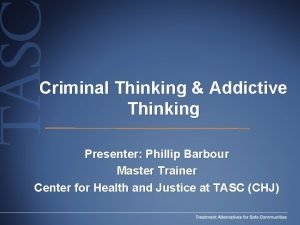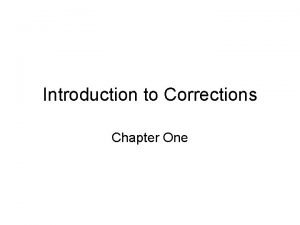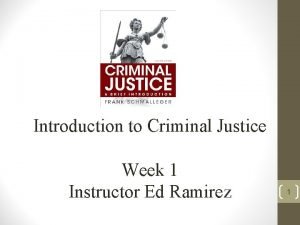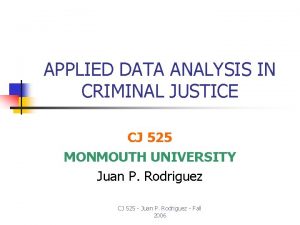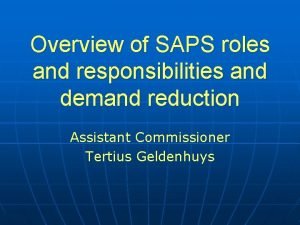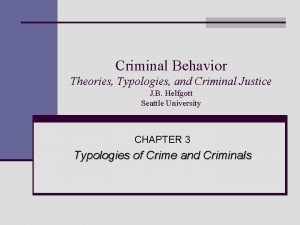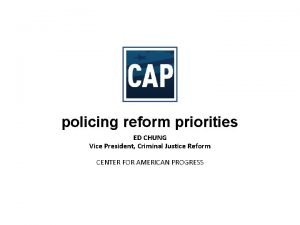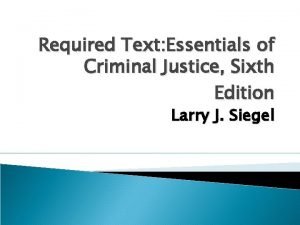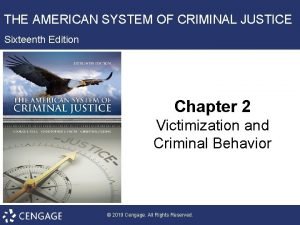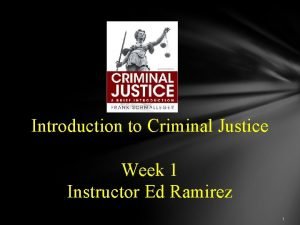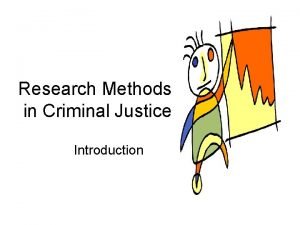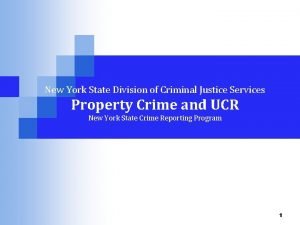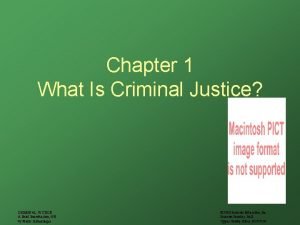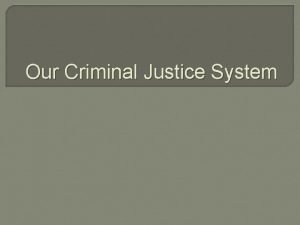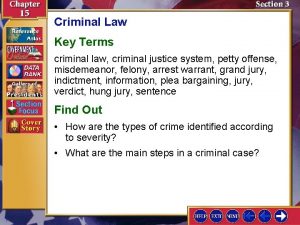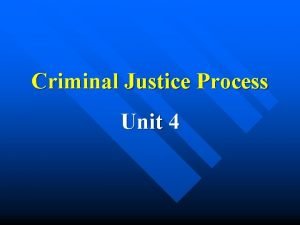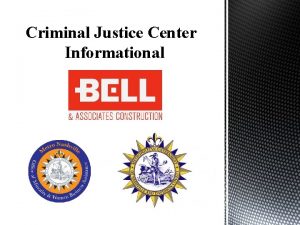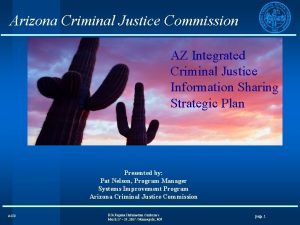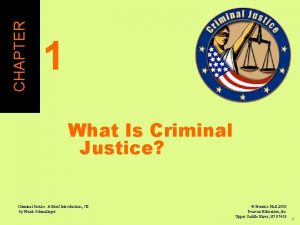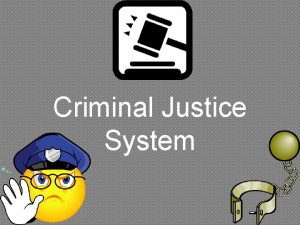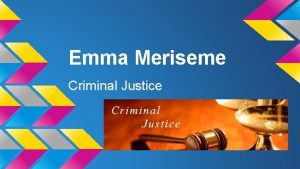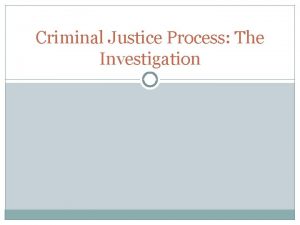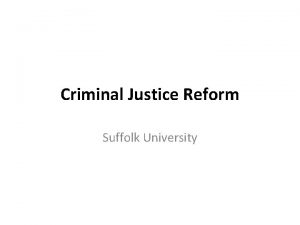INTRO TO CORRECTIONS CRIMINAL JUSTICE WHAT IS CORRECTIONS

















- Slides: 17

INTRO TO CORRECTIONS CRIMINAL JUSTICE

WHAT IS CORRECTIONS? • Corrections is that portion of the criminal justice system charged with carrying out the sentences of our courts. • Corrections refers to the programs, services, agencies and institutions responsible for supervising individuals charged with or convicted of crimes.

CONFLICTING VIEW OF CORRECTIONS • Classical view • Humans have free will and are responsible for their own actions. • This view focuses on crime. • Positivist view • Humans are the product of environmental and cultural influences. • This view focuses on the criminal.

CORRECTIONAL IDEOLOGIES • Punishment: Justice model • Assumes offenders are victims of society and their environment who need to be cured. • Control: Custodial model • Goal is restraint of those convicted

CORRECTIONAL IDEOLOGIES • Treatment: Medical model • Assumes offenders are selfdirected, acting on free will and are responsible for their crimes • Prevention: Reintegration model • Goal is to prevent further offenses

People in Each Category of Correctional Supervision

PROBATION • The oldest community-based correctional program. • The most common alternative to a prison sentence. • Offender is put under the control, supervision and care of a probation field staff member in lieu of imprisonment as long as the probationer meets certain standards of conduct. • Allows offenders to remain in the community, able to maintain important family ties and fulfill vital work, family and community obligations.

WHO GETS PROBATION? • First-time offenders • Property offenders • Low-risk offenders • Nonviolent offenders

CONDITIONS OF PROBATION • The general purpose of probation is to help offenders maintain law-abiding behavior through supervision. • One universal condition for all probationers is to obey the law. • Other conditions may include • • • Adherence to a curfew Maintaining steady employment Completing prescribed training Meeting family responsibilities Staying away from certain types of people or places Abstaining from drug and alcohol use Abiding by firearms possession restrictions Performing community service Making restitution

INCARCERATION • The primary goal of these correctional institutions is to protect society. • Secondary goals include • Deterring offenders • Rehabilitating offenders • Reintegrating offenders

JAILS • Detain individuals waiting to appear before the court • For trial (preconviction) • For sentencing (postconviction) • Hold those sentenced to a year or less of incarceration • Jail differs from prison in that • Inmates are there for shorter terms, usually for less serious crimes. • Jails are usually the responsibility of local or county law enforcement.

LANCASTER COUNTY JAIL • Opened in July 2013 • West O St. • 786 inmate capacity • Living Quarters • • 6 Gen Pop Pods 12 Gen Pop Dorms Segregation Pod Mental Health Pod • 29 multipurpose rooms for classes • GED, AA, NA, Release & Restored, Religion, Work Release

PRISONS • Where the inmates have been convicted of a crime • Holds offenders sentenced to more than one year of incarceration • May be punitive • More formal and rigid • Emphasis on obedience through negative incentives • May be treatment-oriented • More informal and flexible • Positive incentives through good behavior

NEBRASKA STATE PRISON SYSTEM • Lincoln Correctional Center (506 pop) • Nebraska Correctional Center for Women (322 pop) • Nebraska State Penitentiary (1319 pop) • Omaha Correctional Center (761 pop) • Tecumseh State Correctional Institution (1014 pop)

PAROLE • The conditional release from prison before the expiration of the sentence and the period of supervision in the community following this release • Differs from probation in that a person who is paroled has spent some time serving a prison sentence • Required supervision and a set of certain conditions the offender must meet

FACTORS W/ ELIGIBILITY OF PAROLE • Type of offense committed • Offender’s prior record • State statutes • Inmate’s behavior while incarcerated • Participation in programs • Whether the inmate has a plan for life on the outside • If the inmate poses any public risk

CONDITIONS OF PAROLE • Regular meetings between the parolee and officer • Requirement to hold a job • Promise to act lawfully • Restriction on leaving the county or state without permission • Prohibition on purchasing or using a firearm • Submission to random or routine drug testing
 Criminal justice corrections
Criminal justice corrections What is criminal thinking
What is criminal thinking Intro to corrections
Intro to corrections Consensus model criminal justice
Consensus model criminal justice Southern connecticut state university public health
Southern connecticut state university public health Data analysis in criminal justice
Data analysis in criminal justice Responsibilities and functions of saps
Responsibilities and functions of saps Criminal typology
Criminal typology Everyday ethics for the criminal justice professional
Everyday ethics for the criminal justice professional Prioritiesed
Prioritiesed Funnel effect criminal justice
Funnel effect criminal justice Unit 2 criminal law and juvenile justice
Unit 2 criminal law and juvenile justice The american system of criminal justice 16th edition
The american system of criminal justice 16th edition Consensus model criminal justice
Consensus model criminal justice Inaccurate observation in criminal justice
Inaccurate observation in criminal justice Department of criminal justice services ny
Department of criminal justice services ny Guelph cjpp
Guelph cjpp Consensus model criminal justice
Consensus model criminal justice

